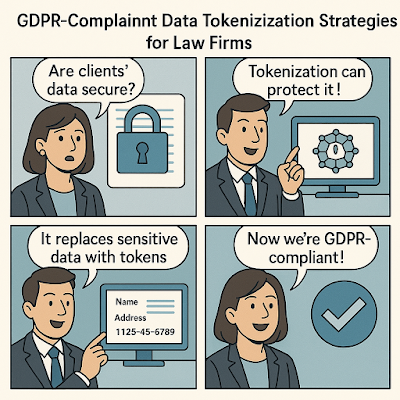GDPR-Compliant Data Tokenization Strategies for Law Firms
Law firms handle vast amounts of sensitive client data—everything from identification details to confidential contracts and litigation materials.
With the enforcement of GDPR and similar privacy regulations globally, ensuring the security of personal data is not just best practice—it's a legal necessity.
One powerful approach to achieving GDPR compliance is data tokenization: a process that replaces sensitive data with non-sensitive tokens while preserving functionality.
In this post, we’ll explore how law firms can implement GDPR-compliant tokenization strategies and the tools that can help streamline that transition.
🔗 Table of Contents
- Why Tokenization Is Vital for Legal Data
- How Data Tokenization Works
- What GDPR Requires
- How to Implement It in a Law Firm
- Final Thoughts
🔐 Why Tokenization Is Vital for Legal Data
Legal documents frequently contain personal data, financial records, medical histories, or trade secrets.
When this data is exposed or mismanaged, it can result in massive reputational damage and regulatory fines.
Tokenization neutralizes this risk by substituting sensitive information with a meaningless surrogate (token) stored securely in a vault.
⚙️ How Data Tokenization Works
Unlike encryption, which transforms data using algorithms, tokenization removes sensitive data entirely from your system.
For example, a client's national ID number might be replaced with "abc-123"—a token that has no exploitable value if breached.
Access to real data is restricted and logged, allowing full auditability.
📜 What GDPR Requires
GDPR Article 32 mandates technical and organizational measures to secure personal data, including pseudonymization techniques like tokenization.
It also encourages data minimization, purpose limitation, and the ability to demonstrate compliance—all enhanced by tokenization.
Additionally, tokenized data often falls outside the scope of breach reporting if the tokens are rendered meaningless without access to the vault.
🏛️ How to Implement It in a Law Firm
Audit your firm’s personal data flows and identify high-risk repositories.
Select a tokenization platform that supports vault-based storage with GDPR-grade logging and encryption (e.g., Protegrity, Thales CipherTrust).
Integrate tokenization APIs into your case management, billing, and eDiscovery tools.
Ensure role-based access and train legal staff on proper handling procedures.
💡 Final Thoughts
Data tokenization is not a luxury—it's becoming an operational necessity for modern legal practices.
By removing sensitive data from core systems and maintaining airtight control over its access, law firms can demonstrate proactive GDPR compliance while earning clients’ trust.
Early adoption of these privacy-enhancing technologies sets your firm apart as a forward-thinking, risk-aware legal service provider.
🔗 Related Resources
📄 Green Supply Chain Contracts & Privacy📊 Predictive Risk Tools in Legal Branding
🌍 Legal Risk Scoring for Climate-sensitive Contracts
🔎 Misinformation Detection in Legal Reviews
🚗 Secure Telematics & Legal Data Governance
Keywords: data tokenization GDPR, legal data compliance, law firm data security, token vault platforms, privacy-enhancing tech

